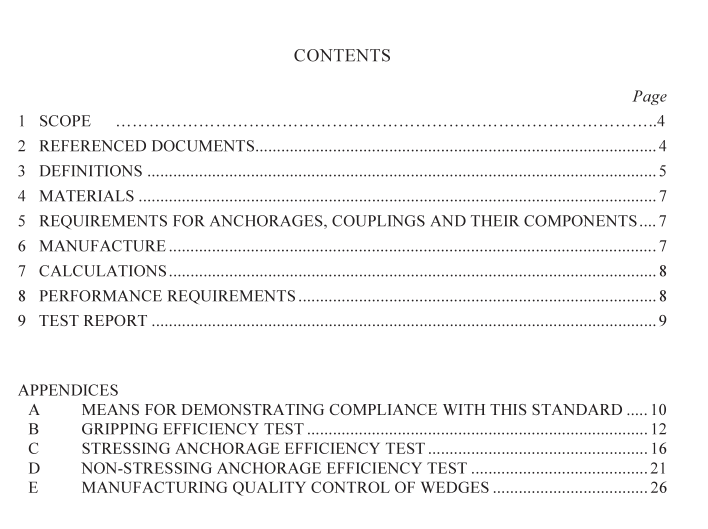AS NZS 1314 pdf download – Prestressing anchorages

AS NZS 1314 pdf download – Prestressing anchorages
3.2.8 Draw-in The movement of a gripping device relative to the anchorage, which takes place during or subsequent to stressing and which is essential to the anchorage’s gripping action. 3.2.9 Excessive deformation Deflections that are equal or greater than the calculated bending deflection, or which are equal or greater than the upper level of elastic deformation prior to plastic deformation or evidence of punching shear occurring at the annular shear perimeters between loading plates.
3.2.10 Failure load The load at which a test specimen is incapable of supporting any increase in load. Failure is any load less than 95% of the minimum tensile strength of the tendon where excessive deformation occurs.
3.2.11 Gripping devices A mechanical device or component for anchoring the strand, wire or bar within an anchorage. Gripping devices include hardened steel wedges, either single or multiple pieces, nuts, compression fittings or similar device to grip or restrain the strand, wire or bar within the anchor plate or barrel without significant relative movement.
3.2.12 Gripping efficiency The ratio of the failure load or maximum test load to the minimum specified load or tendon capacity the anchorage is designed to accommodate when tested in accordance with Appendix B.
3.2.13 Maximum test load The failure load or the highest test load to which the test specimen is subjected where it is unsafe or unnecessary to test it to failure, expressed as a ratio of the specified capacity.
3.2.14 Minimum specified load capacity The product of the maximum number of tendons, which the anchorage is designed to accommodate, and the characteristic tensile strength of the largest tendon force specified by the supplier for use in the anchorage.
3.2.15 Non-stressing anchorage An anchorage, usually entirely encased in the concrete, at which it is intended that stressing not be carried out.
3.2.16 Static tests Tests in which an increasing tensile test load is applied incrementally, by means of calibrated hydraulic jacks or a suitable testing machine, until the maximum or failure load is reached.
3.2.17 Stressing The operation of inducing tension in a tendon.
3.2.18 Stressing anchorage An anchorage located at an end of a tendon at which stressing can be carried out.
3.2.19 Tendon A wire, strand, or bar complying with AS 1310, AS 1311 or AS 1313 respectively, or any discrete group of such wires, strands or bars, which may be stressed in one operation or individually.
3.2.20 Tendon-anchorage assembly A tendon anchorage assembly for strand tendons includes wedges, anchor block, duct transition casing and for bar tendons includes the anchor nut, washer and bearing plate.
4 MATERIALS
4.1 Anchorage components Materials for the anchorage components shall comply with the relevant Australian or New Zealand Standard with respect to both physical and mechanical properties or, if no Australian or New Zealand Standard exists, a relevant International Standard.
4.2 Tendons Tendons used for testing the anchorage and its components shall comply with AS 1310, AS 1311 or AS 1313, as appropriate.
4.3 Concrete Concrete used in the preparation of anchorage test specimens shall comply with AS 1379 or NZS 3108.
5 REQUIREMENTS FOR ANCHORAGES, COUPLINGS AND THEIR COMPONENTS
5.1 General An anchorage, or a coupling, and its component parts shall be considered as a single entity and they shall together satisfy the requirements of Clauses 5.2 and 5.3.
5.2 Safety When concrete in the anchorage zone has been reinforced, cast and cured in accordance with AS 3600 or NZS 3101.1, an anchorage, or a coupling, shall be capable of safely transferring the design forces to the concrete, both during the stressing operation and upon release of the stressing equipment.
5.3 Reliability An anchorage or a coupling shall be capable of maintaining the design prestressing forces imposed on it throughout the service life of the member. NOTE: In the design of an anchorage or coupling, account needs to be taken of some practical considerations including, but not limited to, the following: (a) The shape of the assembly, which should maximize load transfer by bearing and should permit ready compaction of the concrete around it.









